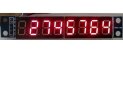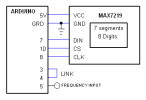C code is for setting timer2 and timer0 to generate 1 second time base divided from the 16MHz crystal, timer1 is the counter. The 7 segment display MAX7219 is driven by software SPI, bit banging the 16 bits command to the display driver. The Arduino uno can count up to 6 MHz so digit 8 is not used. Leading zeros are blanked.
B4X:
Sub Process_Globals
Public Serial1 As Serial
Public DIN As Pin
Public CLK As Pin
Public CS As Pin
Public out6 As Pin
Public out9 As Pin
Public out3 As Pin
Public in4 As Pin
Public in5 As Pin
Public freq As UInt
Public overf As Byte
End Sub
Private Sub AppStart
Dim i As Byte
Serial1.Initialize(9600)
RunNative ("setTimers",Null)
DIN.Initialize(7, DIN.MODE_OUTPUT)
CLK.Initialize(8, CLK.MODE_OUTPUT)
CS.Initialize(10, CS.MODE_OUTPUT)
out6.Initialize(6, out6.MODE_OUTPUT)
out9.Initialize(9, out9.MODE_OUTPUT)
out3.Initialize(3, out3.MODE_OUTPUT)
in4.Initialize(4, in4.MODE_INPUT)
in5.Initialize(5, in5.MODE_INPUT)
'7219 init
cmnd(0x0b, 0x07) 'scan limit
cmnd(0x09, 0xff) 'decode mode
cmnd(0x0f, 0x00) 'no test
cmnd(0x0a, 0x02) 'intensity (second byte) can be 0-15 (0x00-0x0F)
cmnd(0x0c, 0x01) 'shutdown=on
For i=1 To 8 'blank 8 digits
cmnd(i, 0x0f)
Next
cmnd(4, 0x01) 'Hi
cmnd(5, 0x0c)
dly_us
counter
End Sub
Private Sub counter
Private freq2 As ULong
Private i, d(8), nz As Byte
Do While True
Do While out6.DigitalRead=True
Loop
Do While out6.DigitalRead=False 'wait for start of 1 sec
Loop
overf=0
RunNative ("count",Null)
Do While out6.DigitalRead=True
RunNative ("count2",Null)
Loop
RunNative ("count3",Null)
freq2 = overf * 65536 + freq
'Log(freq2)
'convert to decimal
For i=0 To 7
d(i)=freq2 Mod 10
freq2=freq2 / 10
Next
'remove leading zeros
nz=1
For i=8 To 2 Step -1
If d(i-1)=0 And nz=1 Then
cmnd(i, 0x0f)
Else
cmnd(i, d(i-1))
nz=0
End If
Next
cmnd(1, d(0))
Loop
End Sub
'address+data
Sub cmnd(addr As Byte, dataB As Byte)
Dim b As Byte
CS.DigitalWrite(False)
For b=0 To 7
If Bit.ShiftRight(addr,7-b) Mod 2 =1 Then
DIN.DigitalWrite(True)
Else
DIN.digitalWrite(False)
End If
clock
Next
For b=0 To 6
If Bit.ShiftRight(dataB ,7-b) Mod 2 = 1 Then
DIN.DigitalWrite(True)
Else
DIN.DigitalWrite(False)
End If
clock
Next
If dataB Mod 2 = 1 Then DIN.DigitalWrite(True) Else DIN.digitalWrite(False)
CLK.DigitalWrite(True)
dly_us
CS.DigitalWrite(True)
dly_us
CLK.DigitalWrite(False)
dly_us
End Sub
Sub clock
CLK.DigitalWrite(True)
dly_us
CLK.DigitalWrite(False)
dly_us
End Sub
Sub dly_us 'set clk frequency to about 100KHz
Dim j As Byte
For j=0 To 2
j=j
Next
End Sub
#if C
void setTimers(B4R::Object* o)
{
//set timer0 in=250Hz out=1Hz
OCR0A = 249;
TCCR0A=0b1000011;
TCCR0B=0b1110; // PWM mode, input T0 pin D4
// set timer2 in=16MHz out=250Hz
OCR2A =249;
OCR2B = 125;
TCCR2A=0b110011; //output B in phase, fast PWM mode
TCCR2B=0b1110; // set prescaler to 256 and start the timer
// set timer1
OCR1A = 32767; //32768 counts
TCCR1A = 0b1000011;
TCCR1B = 0b11110; //input pin D5
}
void count(B4R::Object* o)
{
TIFR1 |= _BV(1); //reset interrupt
OCR1A = 65535; //32767
TCNT1=0;
}
void count2(B4R::Object* o){
if(TIFR1 & _BV(1)) {(b4r_main::_overf)=(b4r_main::_overf)+1; TIFR1 |= _BV(1);}
}
void count3(B4R::Object* o){
(b4r_main::_freq) = TCNT1 ;
}
#End if


